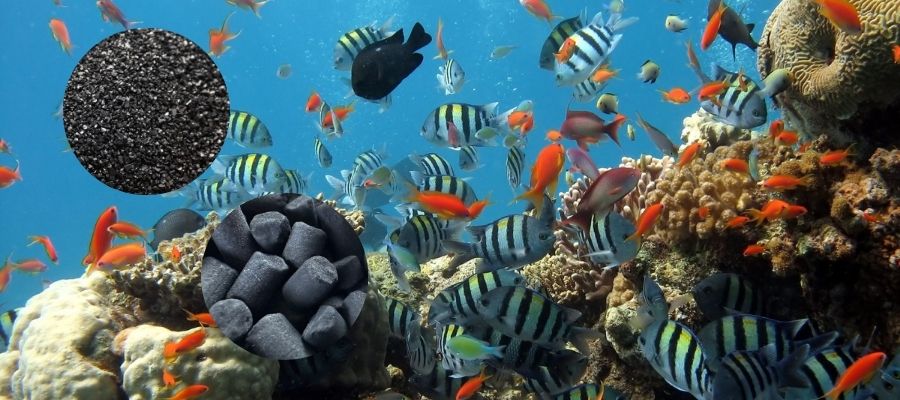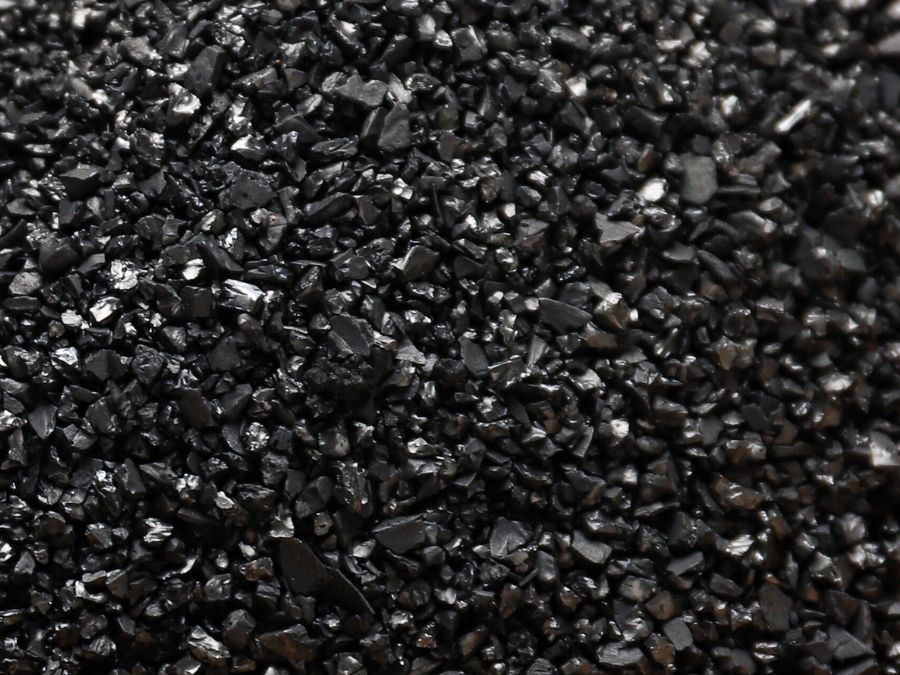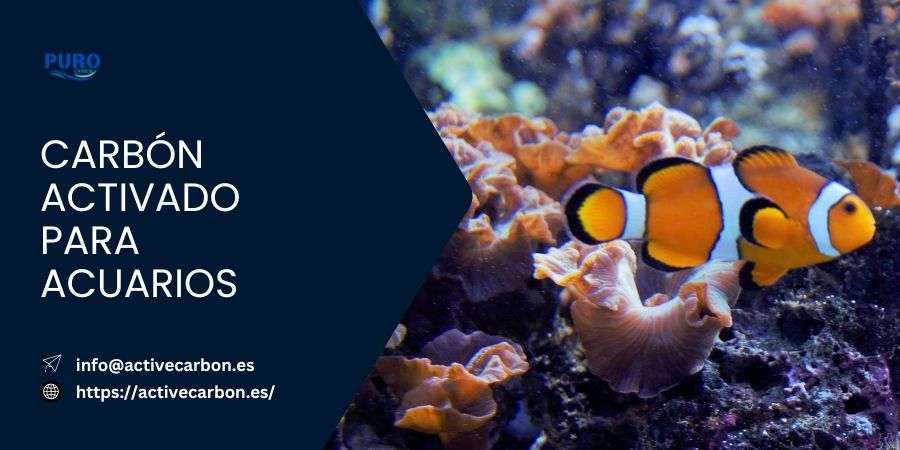En el ámbito de los acuarios profesionales y comerciales, la calidad del agua es un factor decisivo para la supervivencia y la salud de las especies acuáticas, y la forma de controlar eficazmente las sustancias nocivas, los olores y la turbidez del agua es el centro del mantenimiento diario.
Entre los muchos materiales de purificación del agua, el activated carbon se ha convertido en una parte indispensable del sistema de filtración del acuario debido a su excelente capacidad de adsorción. En este artículo, analizaremos la aplicación del carbón activado en acuarios y le ayudaremos a elegir los productos de carbón activado adecuados para acuarios.
¿Qué es el carbón activado y cómo funciona en los sistemas acuáticos?
El carbón activado es un material carbonoso sometido a un proceso especial que le otorga una estructura porosa muy desarrollada y una superficie específica extremadamente alta, lo que le permite adsorber eficazmente impurezas, sustancias químicas y contaminantes orgánicos del agua.
En entornos acuáticos, el carbón activado funciona principalmente mediante adsorción, un proceso fisicoquímico en el que las moléculas contaminantes se adhieren a la superficie del carbón. Gracias a ello, es especialmente eficaz para eliminar:
- Compuestos orgánicos disueltos que causan coloración del agua
- Residuos de medicamentos y tratamientos químicos
- Compuestos que generan malos olores
- Cloro y cloraminas del agua de grifo
- Toxinas producidas por algas u otros organismos
- Taninos y otras sustancias que provocan color amarillo en el agua
Funciones del carbón activado en acuarios

Gracias a sus excepcionales propiedades de adsorción, el carbón activado cumple múltiples funciones en sistemas acuáticos:
Eliminación de compuestos orgánicos disueltos (DOC)
En sistemas con alta densidad de peces, los compuestos orgánicos disueltos se acumulan rápidamente y representan un gran desafío para mantener un ecosistema equilibrado. Estas sustancias provienen de:
- Desechos metabólicos de los organismos acuáticos
- Restos de comida no consumida
- Descomposición de plantas
- Productos del metabolismo bacteriano
El carbón activado atrapa eficazmente estas moléculas orgánicas, impidiendo que degraden la calidad del agua o sirvan como nutrientes para algas o patógenos no deseados.
Adsorción de sustancias químicas nocivas
En un acuario pueden existir residuos de cloro, cloraminas, pesticidas, medicamentos o metales pesados, que llegan a través del agua de red, tratamientos o el entorno exterior. El carbón activado de alta calidad puede adsorber estos contaminantes y proteger la salud de los organismos acuáticos.
Prevención de la proliferación de algas
En acuarios profesionales, especialmente aquellos iluminados intensamente para exhibición, la proliferación de algas puede convertirse en un problema estético y ecológico. El carbón activado ayuda a prevenirla al:
- Eliminar fosfatos y nitratos disueltos que alimentan a las algas
- Adsorber compuestos orgánicos que favorecen su crecimiento
- Reducir la turbidez del agua y potenciar la eficacia de sistemas UV
Selección de carbón activo para acuarios
La selección del tipo y formato de carbón activado es esencial para garantizar la eficacia en la purificación del agua. Según el tipo de acuario, el diseño del sistema de filtración y la facilidad de mantenimiento, se utilizan principalmente dos formas: carbón activado granular y carbón activado en pellets.
Granular activated carbon

Granular Activated Carbon
Suministrado en grandes cantidades, la fuerte adsorción, la alta resistencia mecánica y la gran capacidad de adsorción garantizan un tratamiento eficaz.
Fabricado a partir de cáscara de coco de alta calidad del sudeste asiático, este carbón se somete a un proceso de activación cuidadoso para lograr una estructura porosa muy desarrollada. Se presenta en forma de partículas irregulares con un tamaño típico de 0,5 a 4,0 mm.
Advantages:
- High specific surface: su estructura microporosa permite adsorber eficazmente materia orgánica, cloro, olores y pigmentos.
- Compatible con sistemas de filtración convencionales: ideal para filtros de mochila, filtros por goteo y filtros externos.
- Velocidad de flujo adecuada: permite un contacto prolongado con el agua, mejorando la eficiencia de adsorción.
- Fácil mantenimiento: se puede reemplazar fácilmente para mantener su eficacia.
Aplicaciones típicas:
Acuarios domésticos de agua dulce o salada con necesidades medias-altas de control de materia orgánica.
Activated carbon pellets

Activated carbon pellets
Diseñado para caudales elevados, sistemas de acuarios grandes o especializados. Rendimiento constante, presupuestado de fábrica.
Fabricado a partir de antracita de alta calidad mediante procesos complejos, se presenta en forma cilíndrica, normalmente de 3 mm o 4 mm de diámetro.
Advantages:
- High mechanical strength: no se fragmenta fácilmente, incluso en entornos con alto flujo de agua o limpieza frecuente.
- Bajo contenido de cenizas y alta porosidad: reduce la turbidez del agua y mejora la capacidad de adsorción.
- Ideal para sistemas industriales o de gran escala: excelente rendimiento en criaderos, acuarios públicos y otros sistemas con alta demanda de calidad del agua.
- Larga vida útil: requiere menos reemplazo, lo que reduce la frecuencia de mantenimiento.
Aplicaciones típicas:
Acuarios comerciales o públicos, y sistemas de acuicultura que requieren funcionamiento continuo y estable.
Conclusion
El uso de carbón activado en acuarios es una solución eficaz para mejorar y mantener la calidad del agua. Elegir el tipo adecuado y aplicarlo correctamente garantiza un entorno saludable para peces y plantas acuáticas.
Si estás buscando un proveedor confiable de carbón activado, no dudes en contact us at. Podemos ofrecerte soluciones personalizadas para tu sistema acuático.
